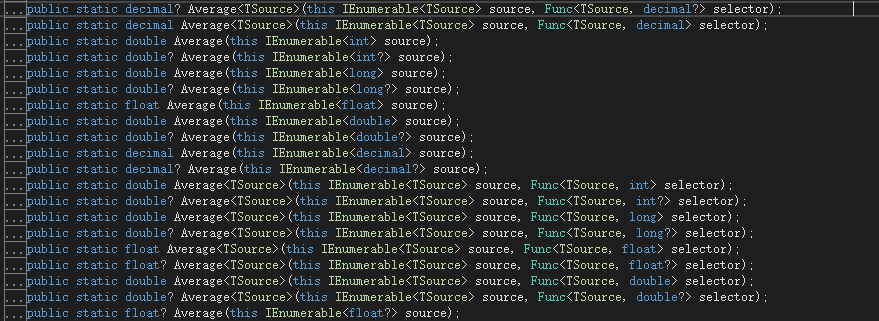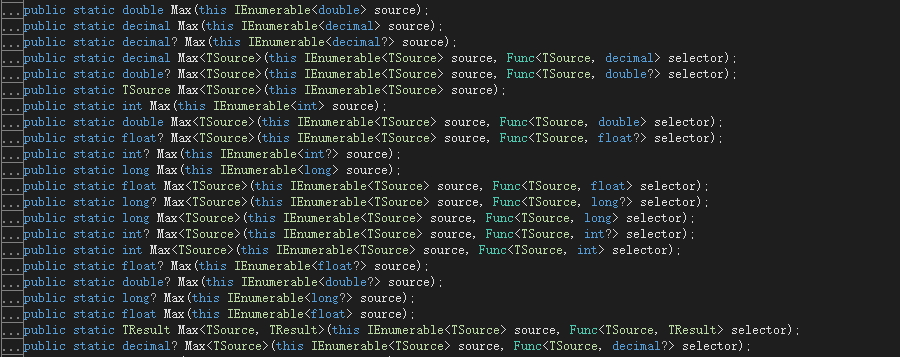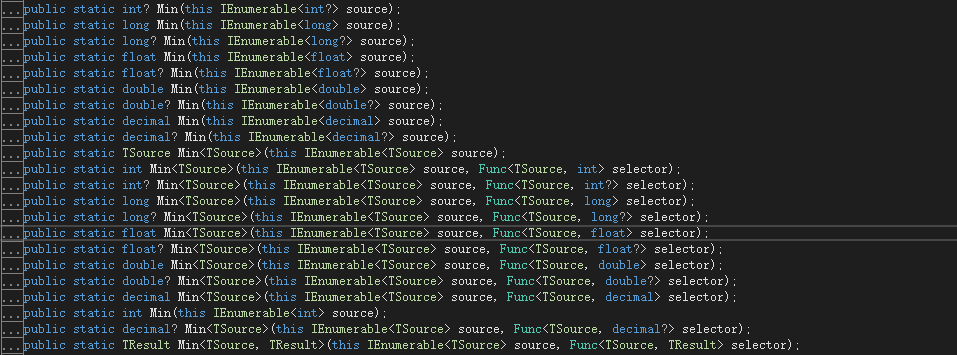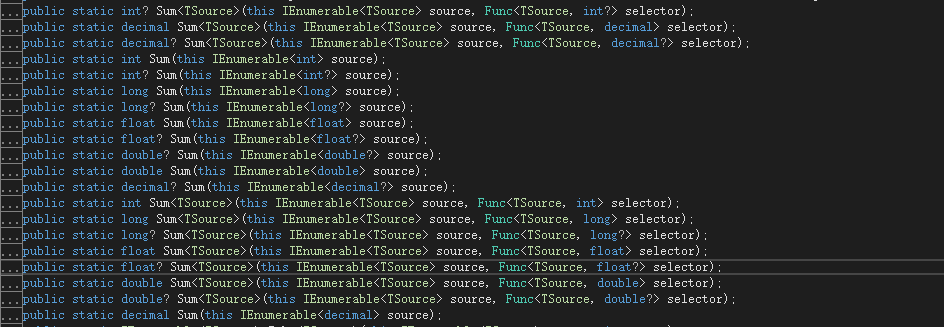一、Aggregate操作符
Aggregate操作符对集合值执行自定义聚合运算。来看看Aggregate的定义:
1 public static TSource Aggregate<TSource>(this IEnumerable<TSource> source, Func<TSource, TSource, TSource> func); 2 public static TAccumulate Aggregate<TSource, TAccumulate>(this IEnumerable<TSource> source, TAccumulate seed, Func<TAccumulate, TSource, TAccumulate> func); 3 public static TResult Aggregate<TSource, TAccumulate, TResult>(this IEnumerable<TSource> source, TAccumulate seed, Func<TAccumulate, TSource, TAccumulate> func,
Func<TAccumulate, TResult> resultSelector);
可以看到Aggregate共有三个方法重载,这里以第一个重载方法为例。第一个重载方法里面的第二个参数是一个委托,委托的参数类型都是集合的元素类型,委托的返回值类型也是集合元素类型。例如:列出所有产品清单,每个产品名称之间用顿号连接。
先定义Product类:
1 using System; 2 using System.Collections.Generic; 3 using System.Linq; 4 using System.Text; 5 using System.Threading.Tasks; 6 7 namespace TogetherOperation 8 { 9 public class Product 10 { 11 public int Id { get; set; } 12 public int CategoryId { get; set; } 13 public string Name { get; set; } 14 public double Price { get; set; } 15 public DateTime CreateTime { get; set; } 16 } 17 }
在Main()方法中调用:
1 using System; 2 using System.Collections.Generic; 3 using System.Linq; 4 using System.Text; 5 using System.Threading.Tasks; 6 7 namespace TogetherOperation 8 { 9 class Program 10 { 11 static void Main(string[] args) 12 { 13 List<Product> listProduct = new List<Product>() 14 { 15 new Product(){Id=1,CategoryId=1, Name="C#高级编程第10版", Price=100.67,CreateTime=DateTime.Now}, 16 new Product(){Id=2,CategoryId=1, Name="Redis开发和运维", Price=69.9,CreateTime=DateTime.Now.AddDays(-19)}, 17 new Product(){Id=3,CategoryId=2, Name="活着", Price=57,CreateTime=DateTime.Now.AddMonths(-3)}, 18 new Product(){Id=4,CategoryId=3, Name="高等数学", Price=97,CreateTime=DateTime.Now.AddMonths(-1)}, 19 new Product(){Id=5,CategoryId=6, Name="国家宝藏", Price=52.8,CreateTime=DateTime.Now.AddMonths(-1)} 20 }; 21 22 // 1、Aggregate 23 // 因为Name是string类型的,所以委托的参数和返回值的参数类型都是string类型的,直接输出即可 24 // current和next都是listProduct中的Name的值 25 var query = listProduct.Select(c => c.Name).Aggregate((current, next) => string.Format("{0}、{1}", current, next)); 26 Console.WriteLine(query); 27 Console.ReadKey(); 28 } 29 } 30 }
结果:

从结果可以看出:最后输出的结果是Name拼接的值,并且以顿号进行分割。
二、Average操作符
Average操作符和T-SQL中的Avg效果一样,是求集合中元素的平均值,来看看Average的方法定义。

可以看出Average有很多方法的重载,可以直接对基本数据类型的集合求平均值,也可以对其他类型集合中的某个元素求平均值,来看下面的示例:
1、直接求基本类型集合的平均值
1 List<int> list = new List<int>(); 2 list.Add(1); 3 list.Add(3); 4 list.Add(4); 5 list.Add(5); 6 list.Add(6); 7 list.Add(10); 8 list.Add(13); 9 var result = list.Average(); 10 Console.WriteLine("平均值:"+result);
结果:

2、求listProduct集合中价格的平均值
1 var result = listProduct.Average(p => p.Price); 2 Console.WriteLine("平均值:" + result);
结果:

三、Count操作符
Count操作符是求集合中元素的个数。返回值类型是Int32。来看看方法的定义:

来看下面的例子:
1 int count1 = listProduct.Count(); //5 2 // 查询出CategoryId为1的集合的个数 3 // 查询表达式 4 int count2 = (from p in listProduct where p.CategoryId == 1 select p).Count(); //2 5 // 方法语法 6 int count3 = listProduct.Count(p => p.CategoryId == 1); //2 7 Console.WriteLine(count1); 8 Console.WriteLine(count2); 9 Console.WriteLine(count3);
结果:

四、LongCount操作符
LongCount操作符也是求集合中元素的个数。返回值类型是Int64。来看看方法的定义:

来看下面的例子:
1 long count1 = listProduct.LongCount(); //5 2 // 查询出CategoryId为1的集合的个数 3 // 查询表达式 4 long count2 = (from p in listProduct where p.CategoryId == 1 select p).LongCount(); //2 5 // 方法语法 6 long count3 = listProduct.LongCount(p => p.CategoryId == 1); //2 7 Console.WriteLine(count1); 8 Console.WriteLine(count2); 9 Console.WriteLine(count3);
结果:

五、Max操作符
Max操作符是求集合中元素的最大数。来看看方法的定义:

从方法定义中可以看出:Max操作符既可以求基本数值类型集合的最大值,也可以求其他类型集合中满足条件的最大值。看下面的例子:
1 List<int> list = new List<int>(); 2 list.Add(1); 3 list.Add(3); 4 list.Add(4); 5 list.Add(5); 6 list.Add(6); 7 list.Add(10); 8 list.Add(13); 9 Console.WriteLine(list.Max()); //13 10 Console.WriteLine(listProduct.Max(p => p.Price)); //100.67 11 Console.WriteLine((from p in listProduct select p.Price).Max()); //100.67
结果:

六、Min操作符
Min操作符是求集合中元素的最小值。来看看定义:

从方法定义中可以看出:Min操作符既可以求基本数值类型集合的最小值,也可以求其他类型集合中满足条件的最小值。看下面的例子:
1 List<int> list = new List<int>(); 2 list.Add(1); 3 list.Add(3); 4 list.Add(4); 5 list.Add(5); 6 list.Add(6); 7 list.Add(10); 8 list.Add(13); 9 Console.WriteLine(list.Min()); //1 10 Console.WriteLine(listProduct.Min(p => p.Price)); //52.8 11 Console.WriteLine((from p in listProduct select p.Price).Min()); //52.8
结果:

七、Sum操作符
Sum操作符是求集合中元素的和。来看看定义:

从方法定义中可以看出:Sum操作符既可以求基本数值类型集合中元素的和,也可以求其他类型集合中满足条件的元素的和。看下面的例子:
1 List<int> list = new List<int>(); 2 list.Add(1); 3 list.Add(3); 4 list.Add(4); 5 list.Add(5); 6 list.Add(6); 7 list.Add(10); 8 list.Add(13); 9 Console.WriteLine(list.Sum()); //42 10 Console.WriteLine(listProduct.Sum(p => p.Price)); //377.37 11 Console.WriteLine((from p in listProduct select p.Price).Sum()); //377.37
结果:
